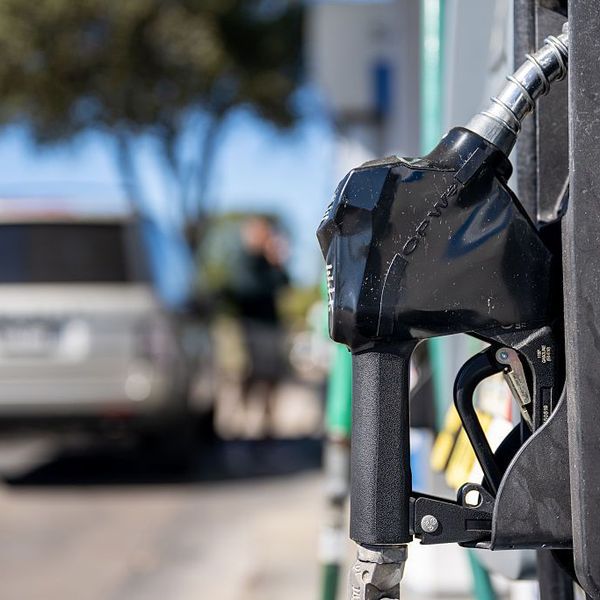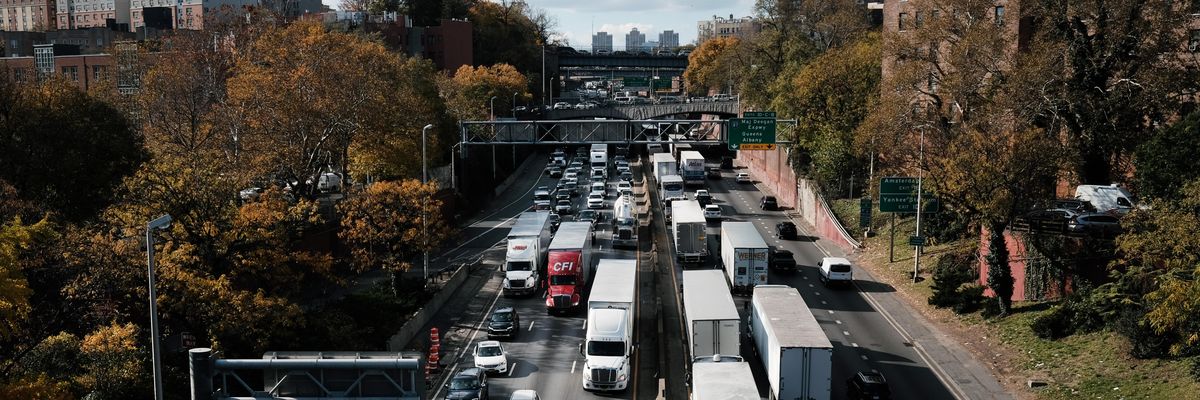After being accused last week of caving to Big Auto and Big Oil on passenger car and light-duty truck pollution standards, the Biden administration came under fire again on Friday for inadequate new rules on buses and freight trucks.
While the U.S. Environmental Protection Agency circulated some praise for the administration's announcement from some green groups and congressional Democrats, Earthjustice president Abigail Dillen said in a statement that "the EPA did not go far enough to protect communities from dangerous health impacts linked to heavy-duty truck pollution."
The rules will increasingly restrict the amount of pollution allowed for over 100 types of vehicles—from school, shuttle, and transit buses to delivery, public utility, and tractor-trailer trucks—for model years 2027 through 2032. The Washington Post noted that unlike the proposal released last year, "the final rule will not require truck manufacturers to dramatically ramp up the production of cleaner vehicles until after 2030."
The EPA estimates the standards will prevent 1 billion tons of greenhouse gas emissions in a country where transportation is the top source of planet-heating pollution and "provide $13 billion in annualized net benefits" for truck owners and operators, the changing climate, and the 72 million Americans—disproportionately those with low incomes and people of color—whose health is at risk because they live near freight routes.
"We have the technology to be more ambitious and missed the opportunity to do more to clean up the freight sector."
"Diesel trucks not only spew tons of carbon dioxide into the air, they also choke communities all along our freight corridors with deadly air pollution, including nitrogen oxides and soot emissions," said Dillen. "This rule could have provided relief to communities across the country by driving a more ambitious transition to zero-emissions technology, which is also what the climate crisis demands. Instead, truck manufacturers have pushed EPA to slow-walk this change."
Steven Higashide, director of the Clean Transportation Program at the Union of Concerned Scientists, pointed out that "heavy- and medium-duty trucks make up only 10% of the vehicles on the road but contribute 28% of transportation-related global warming pollution, along with 45% of nitrogen oxides and 57% of fine particulate matter from on-road vehicles."
"Over 1,000 scientists called for the strongest possible rule and this rule falls short," he said. "We have the technology to be more ambitious and missed the opportunity to do more to clean up the freight sector, especially the heaviest and most polluting vehicles."
Not only does the United States have the technology, but "thanks to the Inflation Reduction Act and the Bipartisan Infrastructure Law, we have the resources to modernize our freight system," noted Dillen, referring to a pair of landmark laws signed by President Joe Biden in 2022 and 2021.
"We will continue to push federal agencies to adopt standards and policies that will drive us towards zero-emissions trucks," she pledged. "In the absence of that federal leadership, EPA must quickly authorize strong state standards that will lead the way on cleaning up freight pollution, and work with the other federal agencies to deploy investments in freight-impacted communities to support state and local efforts to achieve broad freight electrification."
"Every wheeze, every gasp for breath in communities impacted by the movement of freight serves as a reminder of the urgency to act."
Guillermo Ortiz, clean vehicles advocate at the Natural Resources Defense Council, celebrated the public health and climate benefits of the EPA standards while similarly stressing that "this rule could have done more."
"Our nation needs a vision to eliminate pollution from the freight transportation system," Ortiz argued. "Every wheeze, every gasp for breath in communities impacted by the movement of freight serves as a reminder of the urgency to act. The federal government needs to fully address this scourge on our families."
Sierra Club president Ben Jealous—who previewed the EPA announcement in a Common Dreams opinion piece earlier this week—also welcomed the administration's attempt to "move the needle on electrifying our biggest, dirtiest vehicles" in a statement Friday.
"Despite the truck and oil industries' relentless lobbying to weaken and delay these lifesaving standards, the Biden administration's new emissions standards for heavy-duty trucks and buses are an important step to address this harmful pollution," Jealous said. However, like Dillen and Ortiz, he emphasized that "even more is needed to address heavy-duty vehicle pollution" and specifically expressed support for the federal government allowing states like California to impose stricter standards.
East Peterson-Trujillo, senior clean vehicles campaigner with Public Citizen's Climate Program, said that "the EPA missed a big off-ramp, but this isn't the end of the road," also calling on the agency to "rapidly authorize the Clean Air Act waivers, allowing states to continue to press manufacturers to reduce the tailpipe pollution contributing to 'diesel death zones,' and put an end to blatant environmental racism."
Evergreen Action vice president Craig Segall agreed that "EPA should now move forward to approve enforcement of the even more rigorous programs developed by the California Air Resources Board and adopted by states across the country to further drive reductions—and create opportunities for even more ambition in future federal standards."
"Federally, we especially need to see full support for electrification for all parts of the freight system, from warehouses to ports, from planes to ships—and will be looking for further work on trucking to complete the work that this rule begins," he continued.
Segall added that "the path is open for these historic actions because President Biden has taken a strategic all-of-government approach, pairing today's announcement with the new national zero-emission freight corridor strategy announced earlier this month."
While the Democratic president has endured criticism for various climate-related decisions during his first term—including refusing to declare a climate emergency, backing the Willow project and Mountain Valley Pipeline, continuing fossil fuel lease sales, and skipping last year's United Nations summit—he has also made high-profile efforts to tackle the global crisis such as signing landmark laws and pausing approvals for liquefied natural gas exports.
Meanwhile, former President Donald Trump, the presumptive GOP nominee for the November election, has pledged to "drill, baby, drill," and a study released earlier this month shows that compared with Biden's plans, the Republican getting a second term would lead to 4 billion more tons of carbon dioxide being released into the atmosphere by 2030—the combined annual emissions of the European Union and Japan.
This post has been updated with comment from Public Citizen and the Moving Forward Network.



